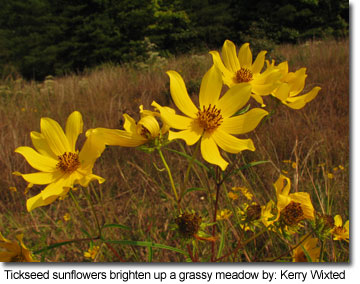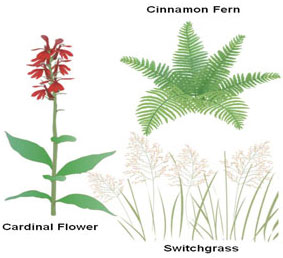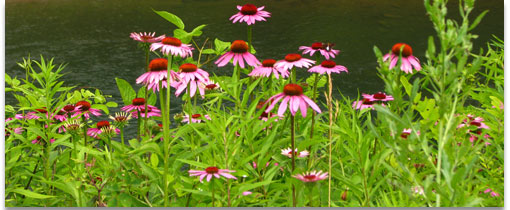Meadows are plant communities comprised mostly of herbaceous (non-woody) plants. The open, sunny areas attract an abundance of wildlife from small mammals and grassland birds to their predators like hawks and owls. These areas are important for nesting, food, shelter and even courtship displays. Despite their importance, the number of meadows around Maryland has declined. However, you can create meadow habitat in your backyard to help increase the survival of species which depend on this unique habitat.
Once established, meadows attract more wildlife and require less maintenance than lawns. In addition, meadows need less water and little to no fertilizer, saving you time and money as well as greening your landscape.

Site Selection
Meadows can be placed in areas that are wet or dry. The major requirement for meadows is full sun for at least six hours a day. Meadows can replace lawns, fields or gardens. When choosing your site, keep in mind that new meadows need to be watered daily. So, these areas should be close to a water source. Try to avoid selecting heavily eroded areas or areas that remain permanently wet. Meadows can be any size, but the larger they are, the better they are for wildlife. After selecting a site, it is good to conduct a soil test to figure out what type of soil you are working with.
Site Preparation
Once you have selected a site, the existing vegetation needs to be removed. Many meadow plants cannot compete with established plants when they are just beginning to grow. Depending on the size of the area, you can either physically remove plants or kill them. If using herbicides, then select ones which do not persist in the soil and do not target seeds like glyphosate-based herbicides. Close mowing two weeks prior to spraying is recommended to stimulate weed growth. Be sure to comply with herbicide application laws and avoid applying herbicides on wet plants or just before a rainstorm. Dead plant material should be removed a week after herbicide application. Other ways to kill plants include using black plastic to smother existing vegetation or repeatedly deep tilling soils every three weeks during growing season (April-September).
When the area is bare, water the soil for several weeks. Kill any plants which begin to grow. Occasionally, a second herbicide application is necessary. Remove the dead vegetation and till the top layer of the soil to remove any root material. Avoid using fertilizer or lime after preparing the soil as these amendments can encourage weeds to grow. Most meadow plants thrive in acidic, nutrient poor soils.
Once the site is bare, and the soil has been tilled, seeds or seed plants can be planted. Typically, fall seeding is recommended as many times, it takes a summer to prepare the site. However, if the site is clear, then you can plant in spring as well.
Plant Selection
When selecting plants for your meadow, it is important to determine your goals for the area. Do you want to provide food for certain species of wildlife? Or would you prefer continuous color from the area? The more diverse your plantings are the greater chance you have for maximizing wildlife usage of your meadow. In addition, it is important to select plants which are not invasive. For a list of commonly planted invasive species, check out the “Bad Plants Planted by Good People” page or the recently revised Plant Invaders of Mid-Atlantic Natural Areas.
Regardless of your choice of plants, you may want to include legumes in the mix. Legumes will help create a natural source of nitrogen to feed the other plants. Legumes are plants that live symbiotically with a type of soil bacteria that produces nitrogen. Nitrogen in the soil provides food for meadow grasses.
Listed below are recommended plants for wet and dry meadows. These plants can be placed into different categories: Ferns (F), Grasses (G), Legumes (L), Rushes and Sedges (S) and Wildflowers (W).
Plants for Wet Meadows

Cardinal flower (Lobelia cardinalis)- W
Cinnamon fern (Osmunda cinnamomea)- F
Eastern gamagrass (Tripsacum dactyloides)- G
Great blue lobelia (Lobelia siphilitica) - W
Green-headed coneflower (Rudbeckia laciniata)- W
Joe Pyeweed (Eupatorium dubium)- W
Monkey flower (Mimulus ringens)- W
Rough goldenrod (Solidago rugosa)- W
Sensitive fern (Onoclea sensibilis) - F
Soft rush (Juncus effusus)- S
Switchgrass (Panicum virgatum)- G
Tall Meadow rue (Thalictrum pubescens)- W
Turk’s cap lily (Lilium superbum)-W
Tussock sedge (Carex stricta)- S
White turtlehead (Chelone glabra)-S
Plants for Dry Meadows

Beardtongue (Penstemon digitalis)-W
Bee balm (Monarda didyma)- W
Big bluestem (Andropogon gerardii)- G
Black-eyed susan (Rudbeckia hirta)- W
Blazingstar (Liatris spicata)- W
Canada wild rye (Elymus canadensis)- W
Common milkweed (Asclepias syriaca)- W
Butterflyweed (Asclepias tuberosa)- W
Evening primrose (Oenothera biennis)- W
Indian grass (Sorghastrum nutans)- G
Little bluestem (Schizachyrium scoparium)- G
New England aster (Aster novae-angliae)-W
New York ironweed (Vernonia noveboracensis)-W
Partridge pea (Chamaecrista fasciculata)- L
Purple coneflower (Echinacea purpurea)- W
Purpletop (Tridens flavus)- G
Roundhead bush clover- (Lespedeza capitata)- L
Spotted beebalm (Monarda punctata)- W
Sunflowers (Helianthus annuus) -W
Virginia wild rye (Elymus virginicus)- G
It should be noted that cheaper seeds and brands from national or regional distributors could have a large percentage of seed that is not viable. This means less seed will germinate. Also, pre-mixed blends of seeds often contain seeds that have incompatible environmental requirements. The best way to buy seeds for your meadow is to use a reputable, specialized source, which can help put together a mix that is fresh and contains varieties of plants that work well together and in the environment you can provide. Follow the seeding rate recommended by the nursery that prepared your mix. When ordering seed, be sure to ask for "Pure Live Seed" (PLS). PLS is the percentage of live (viable) seed found in a bulk seed bag. A bag of bulk seed should be at least 75 percent PLS for good meadow establishment. The remaining percentage of the bulk seed bag contains plant parts.
For mixes with warm-season grasses, the Department of Natural Resource recommends the following seeding rate/acre in pounds of pure live seed:
-
Upland/Dry Soils-Grasses: 3 lbs. Indian Grass, 2 lbs. Big bluestem, 1 lb. Little bluestem with your choice of legumes and forbs.
-
Lowland/Moist Soils-Grasses: 3 lbs Big bluestem, 2 lbs. Indian Grass, 1 lb. Switchgrass with your choice of legumes and forbs.
After you have decided on which plants to include, you have to choose a method of planting your meadow. Depending on your budget, your time and size of area, you can start slow or fast. Even if you plant full-size plants, chances are they will need several years to settle in and weave their roots together. The following list contains ways in which to plant your meadow.
-
Sow seeds. The seedbed must be firm when you plant, and seeds should be planted at a depth of 1⁄2 inch.
-
Plant "seed" plants. Let the seed plants spread, or help them by scattering their seeds
-
Plant "plugs" or bare-root plants. After planting, mulch in between them (lowest maintenance but most initial work)
-
Plant some plants and scatter seeds between them.
Once everything has been planted, maintenance is relatively low. In the first year, when plants reach 12-18 inches in height, mow them down to 6 inches. Do not mow less than 6 inches as this can encourage weed growth. Most native plants will have extensive root systems by their first year, so mowing them will not damage them.
In the second year, cut back plants to about one foot high since plants will be larger. This can be achieved using a string trimmer for smaller areas. Don’t use herbicides!
In the third year, burn the field (if possible). If burning is not possible, then mow the field close to the ground in late Fall or early Spring. Be sure to remove debris to allow plants to grow. Fall is usually the best time for this maintenance as many animals nest in meadows in the spring.

Invite Wildlife to Your Backyard!
For Additional Information, Contact:
Maryland Department of Natural Resources
Wildlife and Heritage Service
Tawes State Office Building, E-1
Annapolis MD 21401
410-260-8540
Toll-free in Maryland: 1-877-620-8DNR
[email protected]
Acknowledgements:
- Tickseed sunflower meadow by Kerry Wixted
- Cardinal flower, Cinnamon fern, Indian grass, Little bluestem and Purpletop by: Tracey Saxby, IAN Image Library (ian.umces.edu/imagelibrary/)
- Switchgrass by: Kim Kraeer and Lucy Van Essen-Fishman, IAN Image Library (ian.umces.edu/imagelibrary/)
- Purple coneflower meadow by Kerry Wixted